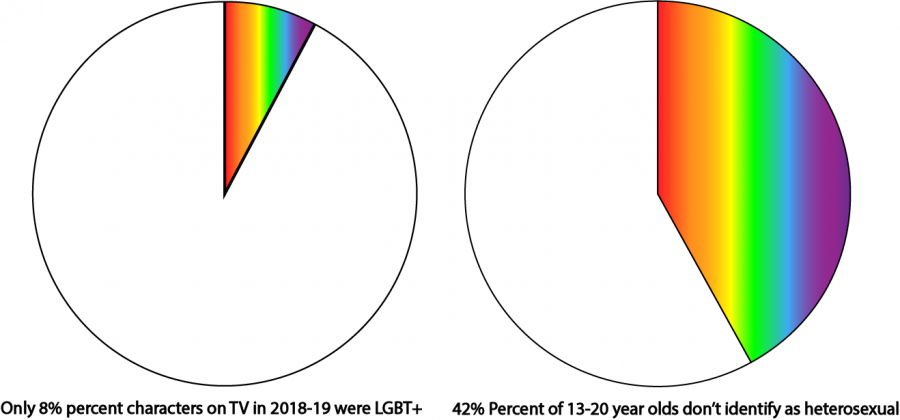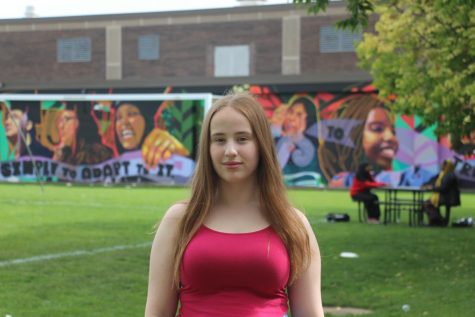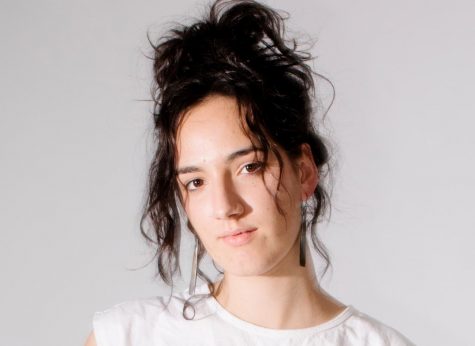We need better LGBT+ representation in entertainment media
GLAAD’s Where Are We On TV Report found an alarmingly low percent of LGBT+ characters expected to appear in broadcast scripted primetime programming in the 2018-19 season. This is extremely disproportionate to the 42% of 13-20 year-old Americans who identify as not heterosexual, found in a J. Walter Thompson Innovation Group study.
October 25, 2019
LGBT+ people are poorly represented in all traditional forms of media: movies, TV, books and theater. While past decades have brought an increasing number of LGBT+ characters into the limelight, It’s still not enough. In addition, stereotyping and negative tropes add to the discrimination against LGBT+ people.
In GLAAD’s Where Are We On TV Report, it was found that 8.8% of the regular characters that were expected to appear in broadcast scripted primetime programming in the 2018-19 season are LGBT+. That might not seem low, but for the young people consuming this media, it’s next to nothing. A 2016 study by J. Walter Thompson Innovation Group reported that 42% percent of Americans age 13-20 identified as not heterosexual.
Lucy Stich, a tenth grader at South said, “I think there’s a lot more LGBT people in real life than there are on TV shows. It would not be that one gay person and everyone else is straight, that’s very unrealistic.” She added, “I’d like to see a lot more LGBT people of color because a lot of the LGBT characters are white.”
While among LGBT+ characters there’s been a surprisingly high percentage of people of color in the past few years (such as Laverne Cox as Sophia in Orange Is The New Black), GLAAD’s annual Studio Responsibility Index found that there wasn’t a single Asian/Pacific Islander LGBT+ character out of 109 major film releases in 2017.
Other LGBT+ groups have been excluded. Despite Transparent (2014-2019) breaking barriers for transgender representation on television, in film there was not one transgender character in the 110 releases from the 7 major studios in 2018 (GLAAD Studio Responsibility Index 2019).
Additionally, the same study reported that none of the 18 films that fell under the category of animated/family film released by major studios in 2018 included LGBT+ characters.
Harrison Rede is a ninth grader at South who identifies as gender fluid. “There’s only one gender fluid character I can think of, and that is Alex Fiero from the Magnus Chase book series. That’s the only gender fluid person that I’ve seen in the media and that’s actually part of how I realized that I was gender fluid. I once read a short story from Alex’s point of view and everything just clicked at that moment. I was like, wait a minute, that’s me,” said Rede.
Compared to other industries, the entertainment industry seems to be more inclusive, but it actually has a history of homophobia and prejudice.
James Lecesne is an artist and activist, who won an Academy Award for his short film Trevor, which follows a 13 year-old gay teenager in the 1990s. He recently came to South High to co-lead the Future Perfect Project, a series of workshops aimed at providing LGBT+ teens with an opportunity to songwrite and story-tell.
“Being a part of the entertainment world myself, coming into that world, I faced a lot of challenges, and what I would call discrimination… I wasn’t welcomed as a gay man. I was welcomed with my talent, but I was not welcomed to talk about it [being gay] or advertise it or mention it at all. That was made very clear to me,” said Lecesne.
“Queerbaiting” is another problem; it’s a marketing technique where storylines lead you to believe there will be a queer relationship when in the end the characters involved end up being completely straight. It’s a way that the entertainment industry profits off of the LGBT+ community without having actual LGBT+ representation.
After all of this information, the lack of representation overall and in many different aspects of the LGBT+ community is very obvious. Beyond the numbers, there are even more problems resting beneath the surface: LGBT+ characters are commonly side characters who get very little screen time. When they do get screen time, they more often than not perpetuate harmful tropes and stereotypes.
A common stereotype seen in entertainment is the butch lesbian. This character presents a more masculine appearance- short hair, never wears dresses or makeup. While there is nothing invalid in this way of presenting one’s self, it is far from an accurate depiction of all gay women.
Bisexual stereotypes are also harmful. Bisexuals are depicted as indecisive, and are often invalidated as just “going through a phase.”
Lucy Stich gives an example of another bisexual stereotype; “One of my favorite musicals [is] a great musical, Rent, but Maureen is bisexual, and the stereotype of bisexuals, they cheat on people, and they’re not faithful, and they’re unwilling to commit is very reflected in that character because she’s a bi woman.”
Gay male stereotypes are the LGBT+ stereotypes I’ve seen the most in all forms of entertainment. Gay men are commonly portrayed as feminine and/or flamboyant, which isn’t accurate to all gay men. They’re also often side characters playing the comedic relief or being useful only as an emotional support to the lead character. One example of a gay male trope is the “gay best friend.” (e.g., Damien in Mean Girls).
“Bury Your Gays” is a trope where LGBT+ characters are carelessly killed off, obviously indicating that their stories are more dispensible than those of their straight/cis-gender counterparts (e.g., Delphine in Atomic Blonde).
LGBT+ people are often oversexualized in media. Many LGBT+ characters only exist to be shown in romantic relationships, while straight and cisgender characters are shown in all aspects of life: not just the parts that involve sex or romance.
Rede talked about her experience watching the TV series Supergirl, “We just didn’t really see that many queer friendships, it would always be queer love relationships… What we need is queer friendships between the characters and conversations between these characters that show that these people are friends and they know each other and share this common experience.”
Heteronormativity and cisnormativity are barriers that hold the entertainment industry back. When being LGBT+ is normalized in the media, homophobia and transphobia will decrease in society. Every person should be able to see themselves in the media.
James Lecesne shared, “I think one of the signs of progress is to see that characters can be LGBT and it’s not the central issue. They just happen to be bisexual or they just happen to be transgender, as apposed to it being a problem or fitting into some mold or stereotype… I think that we’re at a place where we can begin to explore the intersectionality of who we are: that you can be a father and you can be an activist, you can be a black person and you can be transgender. It’s just one of many things that makes us up.







